OAKLAND, Calif.--(BUSINESS WIRE)--Eminent art dealer Jan David Winitz, whose Claremont Rug Company gallery specializes in art-level Oriental carpets from the “Second Golden Age of Persian Weaving,” has begun to tip to his global clients that a trend which began nearly a decade ago is now a prominent feature among connoisseur collectors.
“Starting in the mid first decade of the current century I began to notice,” he said, “that some of my most avant-garde clients were asking me for quite valuable rugs to display as hanging art. What was once a gradual increase is now a staple of our discussions as the appreciation of the finest of antique Oriental rugs have reached a significant level of prominence in the collecting world.
“One of the factors that might have contributed to this was the sales of an Oriental rug at auction for $33.7 million in 2013. The reaction to the price, 3 ½ times the previous highest price, went far beyond the rug world and I was asked by wire services and publications about what the price might indicate.”
Winitz told reporters that he believed that the best examples of antique Oriental rugs had traditionally been undervalued when compared to other forms of collectibles, including paintings, sculpture and furniture. The price paid for the rug (a mid-17th century The Safavid ‘Sickle Leaf’ Persian Kirman) caught the collective eye of important collectors. At the same time, several internationally prominent museums opened Islamic art sections which prominently featured rugs. As journalists began to write about the rug collections they also noted that important painters, including Matisse and Gauguin, had made references to having been influenced by Oriental rug colors and design.
“Taken together, the art world began to take notice,” said Winitz, author of The Guide to Purchasing an Oriental Rug. His gallery, Claremont Rug Company (www.claremontrug.com), has clients on five continents and includes more than 75 Forbes’ List billionaires among its customers. “Our clients are global and art trends have ways of being communicated among sophisticated buyers.
“The progression of interest has reached the point where many of my most knowledgeable clients have begun to furnish their homes in a very distinct manner: rugs on the walls, then paintings to complement wall-hung rugs and, finally, rugs on the floor. It is really quite astounding how this approach has become relatively de rigueur when I discuss acquisitions with clients.”
Winitz has created a proprietary Oriental Rug Market Pyramid which classifies rugs by their rarity and collectability as fine art and antiques. “My clients are quite specific in their use of the pyramid as they select rugs to serve as wall art or now, increasingly, as pieces on the floor which separate furnishings. Many of them want their finest rugs to be seen and, therefore, are less inclined to place them under furniture. They consider the rugs as both art and precious tangible assets, much in the same way that collectors view classic paintings, antique furniture and sculpture.”
Winitz said, “Because many contemporary homes are characterized by large open spaces, this manner of utilizing rugs creates more intimate conversation areas or striking visual separations. In our world, we say that these rugs are no longer ‘hiding in plain sight.’”
Founded by Winitz in 1980, Claremont Rug Company has an inventory comprised of more than 3500 art-level Oriental rugs acquired privately by the Gallery through its extensive team of global buyer/collectors. “We have unprecedented access to rugs from long-established private rug collections through this proprietary global network which seeks out rugs of great beauty and provenance,” he said.
Carpets in the Claremont inventory (www.claremontrug.com) are valued from $20,000 to more than $500,000 per carpet. The rugs are primarily from the “Second Golden Age,” ca. 1800 to ca. 1910.
About Claremont Rug Company
Jan David Winitz’s Claremont Rug Company (www.claremontrug.com), founded in 1980, is an international art gallery with an inventory devoted entirely to Oriental rugs woven during the “Second Golden Age of Persian Weaving,” (ca. 1800 to ca. 1910). The inventory is comprised of 3500 rugs, all acquired privately. The Gallery, located in Oakland, does not participate in off-site exhibitions, shows or in auctions. Recognized for its “client first” approach, the Gallery offers whole home design consultations and a lifetime trade-in policy. Widely-written about, Winitz has been featured in publications, including Apollo, Art & Antiques, CarpetCollector, the Financial Times of London, Luxury Newswire, the New York Times, Private Air/Luxury Homes, Private Wealth.com, Robb Report, the San Francisco Chronicle, the Wall Street Journal and Worth.



